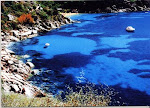The following article on killer whale attacks on humpback whales as discerned through rake mark scars has recently been published:
Steiger, G.H., J. Calambokidis, J.M. Straley, L.M. Herman, S. Cerchio, D.R. Salden, J. Urbán-R, J.K. Jacobsen, O. von Ziegesar, K.C. Balcomb, C.M. Gabriele, M.E. Dahlheim, S. Uchida, J.K.B. Ford, P. Ladron de Guevara-P, M. Yamaguchi and J. Barlow. 2008. Geographic variation in killer whale attacks on humpback whales in the North Pacific: implications for predation pressure. Endangered Species Research 4:247-256.
ABSTRACT: We examined the incidence of rake mark scars from killer whales Orcinus orca on the flukes of humpback whales Megaptera novaeangliae throughout the North Pacific to assess geographic variation in predation pressure. We used 3650 identification photographs from 16 wintering or feeding areas collected during 1990 to 1993 to determine conservative estimates in the percentage of whales with rake mark scarring. Dramatic differences were seen in the incidence of rake marks among regions, with highest rates on wintering grounds off Mexico (26 vs. 14% at others) and feeding areas off California (20 vs. 6% at others), 2 areas between which humpback whales migrate. Although attacks are rarely witnessed, the prevalence of scars demonstrates that a substantial portion of animals are attacked, particularly those that migrate between
The article can be downloaded for free from the publishers website:
http://www.int-res.com/articles/esr2008/4/n004p247.pdf
or from Cascadia Research:
http://www.cascadiaresearch.org/reports/Steiger-etal.2008.pdf
Gretchen H. Steiger
Research Biologist
Cascadia Research
360.943.7325
